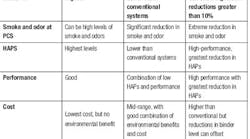Looking to reduce costs in your Phenolic Urethane No Bake (PUNB) operations? Start by choosing the most effective materials. The primary materials in a no-bake operation include binder, aggregate, and refractory coating. There are many available product options and seemingly limitless combinations of those three. The key to choosing the correct combination is to evaluate the total impact on your finished casting cost.
Binder — Many PUNB binders are available and produce good castings. How do you choose the most efficient? When considering a no-bake product, the overall cost should be a balance between material costs, performance, and emissions.
Conventional “economy” binders may seem to offer the lowest costs and are sufficient in many applications. However, compared to a high-performance/low-emission binder such as HAI’s new BioSet T series, the latter offers the same physical properties required at a lower binder percentage. And, the high-performance binder typically helps to reduce core or mold scrap. Despite a higher raw material price, the high-performance binder may deliver the lowest cost casting.
Hybrid binders combine economy with performance, and may improve overall costs. For example, combining BioSet T 8000 part 1 and Techniset 6435 part 2 improves core and cast properties with lower emissions and some of the cost advantage of the economy binder.
The last consideration is high-performance/low-emission binders. PUNB binders contain hazardous air pollutants (HAPs) and are a source of emissions in the casting process. BioSet T8000 part 1 and BioSet T8500 part 2 are newly formulated PUNB binders that combine high-performance characteristics with low HAPs. Low-HAP binders improve the work environment and help foundries meet emission regulations. When high-performance/low-emission binders are used, emissions are lowered through binder reduction. HAP reductions can be clearly quantified and offset potential emission fees.
Three basic PUNB binder options are highlighted in Table 1. When choosing the right binder for your foundry, consider all variables, from material cost to cleaning cost, and be sure to weigh in the environmental impact of the binder.
Aggregate — The most effective way to optimize your aggregate system is to determine your highest-cost areas. Start with castings that incur a lot of scrap or require a lot of cleaning/rework. Silica sand is the most widely used foundry aggregate and can create excellent castings. But, for some castings its expansion and melting point may not be sufficient. For those castings, silica sand additives or specialty sands may save in rework, and so overcome the higher material costs.
Specialty sands typically have high material costs, so reductions and substitutes in this area offer greater savings opportunities. When aggregate prices rise remember there are many specialty sand options that may provide similar properties as your current aggregate.
As with PUNB binders, look at variables affecting sand cost, starting with material costs (sand and binder) and then material requirements. How much sand and binder is required to create each core and each casting? Last, determine the cost to finish and ship each casting. Adding up all variables, the actual cost of the casting may surprise you.
Refractory coating — Refractory coatings are often used to improve surface finish or to provide the extra refractory needed to get more out of your aggregate. The workhorse in a coating is the refractory. The carrier and additives are the vehicle to make the refractory work. The refractory is likely the most expensive material in the coating and will drive the cost of the coating. When coating prices increase, look for alternatives that can do the job done at a lower cost.
Look for refractory substitutions that can fit your system and yield the same casting results. Many different refractories are available with very similar application properties, and it’s likely your supplier has alternate formulations that are a straight refractory substitution for your current coating.
The lesson is the same for all binders, aggregates, and refractory coatings. Determine which material lowers the cost of your finished casting, not just the material cost. Following these guidelines in your PUNB operation, will lead to the best combination for your foundry.
For more information, visit www.ha-international.com










